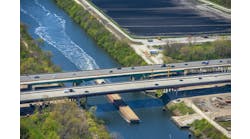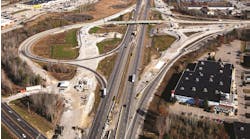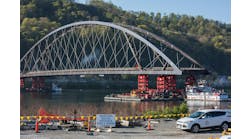As the large vessel crept down the East River, a line of bridges opened wide to let through one of their own.
In a few hours, the final piece of the Willis Avenue Swing Bridge—350-ft-long, 2,500-ton swing span—was in place, and now it was the one clearing a lane for ships and the like.
According to William Nyman, project manager for Hardesty & Hanover LLP, the lead designer during the Willis Avenue gig, which is being called the largest ever undertaken by the Movable Bridge Group of the NYC DOT’s Division of Bridges, moving the swing span 160 miles from its point of origin in Albany, N.Y., and lifting it into its final resting place over the Harlem River was one of the most dramatic aspects of the project.
“There were a lot of difficult parts, but that was the most visible,” Nyman told Roads & Bridges. “We had to pass under a number of bridges that if they were open during rush hour would really mess traffic up. It was a well-orchestrated activity.”
Center barges carried the swing span close to the jobsite, then transferred it over to catamaran barges for the final lift. A combination of tidal action and the ballasting of the barges allowed crews to maneuver the 2,500-ton piece to the top of the center pivot pier. The Coast Guard granted the joint venture of Kiewit Constructors/Weeks Marine Inc. a 60-day window to lock the final segment down, and after the bridge deck was placed traffic was moved off the existing bridge over to the new Willis Avenue swing span.
The entire swing span is centrally supported on what is being called the world’s largest spherical roller thrust bearing, which can rotate but also supports the weight of the swing span. The thrust bearing sits on a bearing housing with a series of 30 rollers around it to allow the span to rotate. Bridges in New York City are now being designed for seismic load, and the bearings in this system have seismic load resistance and are low friction.
In order to ensure a smooth final maneuver, crews constructed the cast-in-place approaches by using a variety of bridge types, including steel curved girders and trapezoidal box girders, tailored to the site constraints.
The bridge is supported by 271 drilled shafts reaching depths up to 140 ft, and the use of 623 minipiles allowed Kiewit/Weeks to handle the tight working environment. Smaller equipment was used for the minipiles, which came in handy in narrow median areas and when work was done under the existing bridge and the RFK Triborough Bridge.
The bridge’s vessel impact protection fender system incorporated more than 800 fiber-reinforced concrete piles. The design also was context sensitive, as plans called for the use of arched pier details reminiscent of the original ones, and granite masonry was repurposed. R&B



